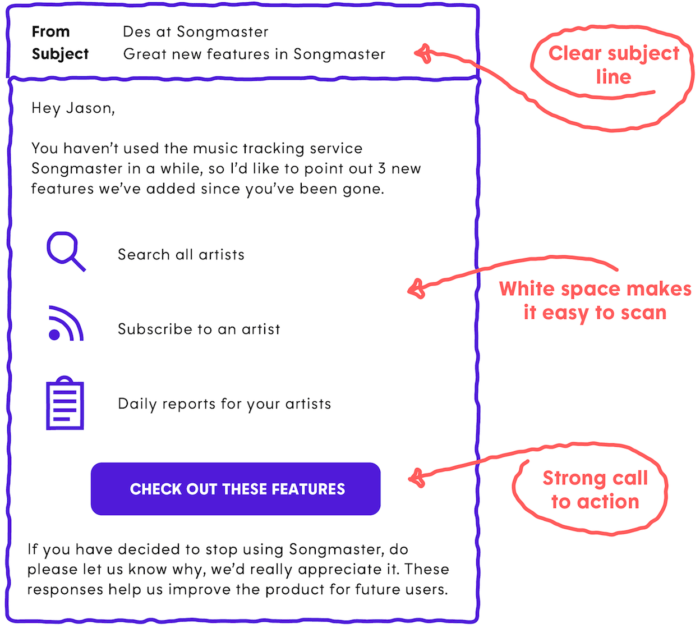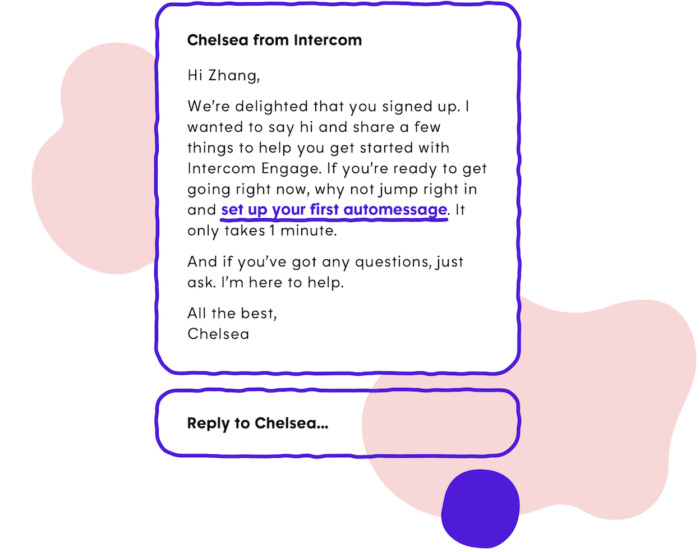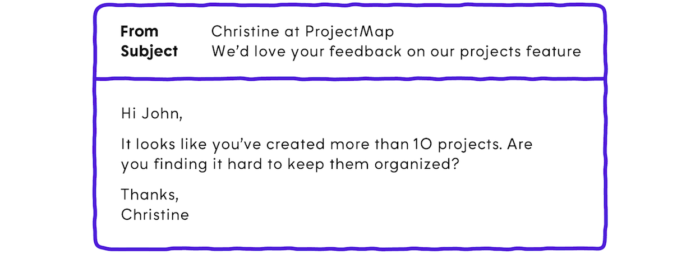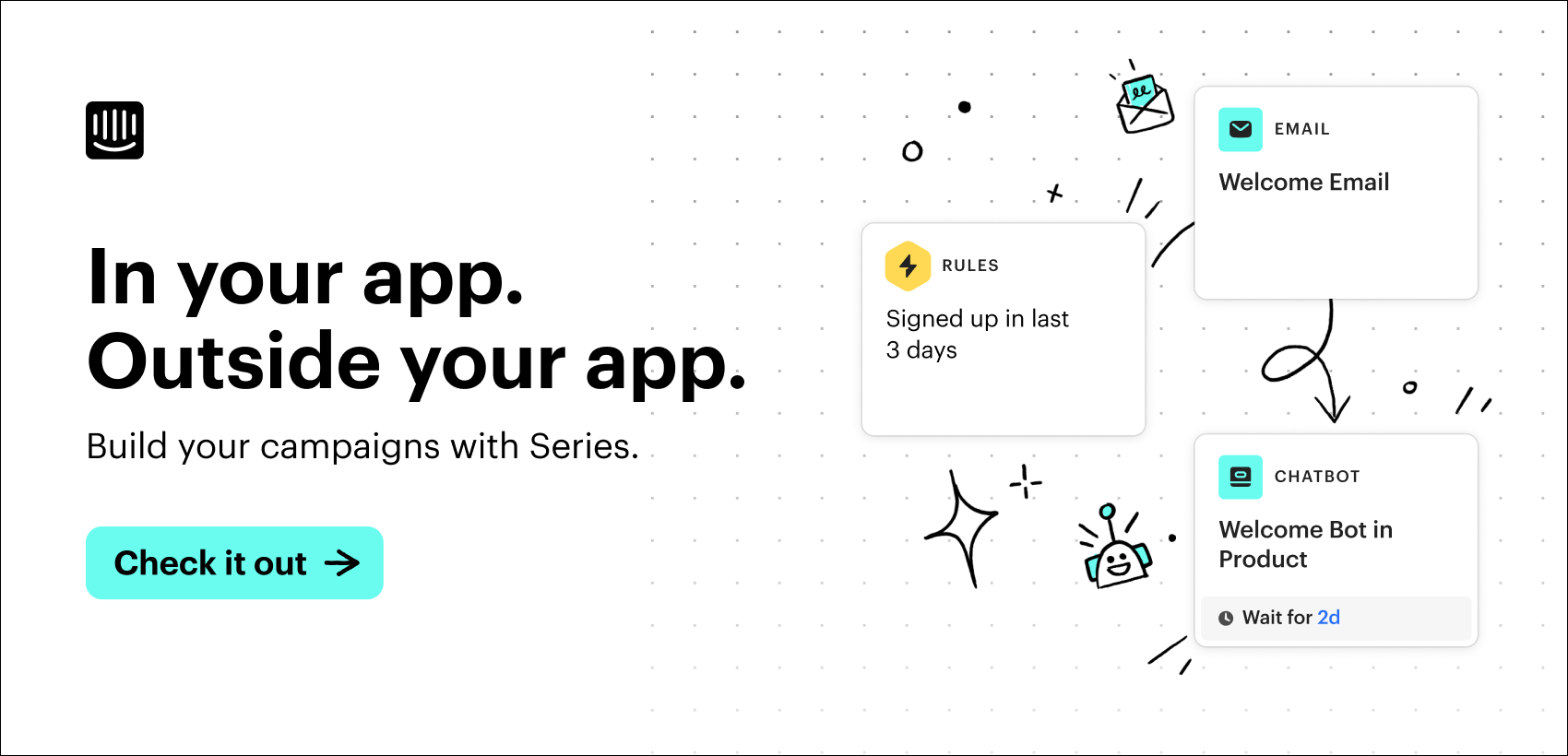
Customer engagement: 5 best practices and 6 examples of effective messages
Main illustration: Logan Faerber
In the world of recurring revenue, more and more companies realize they need engaged customers if they are to grow a healthy, sustainable business – you have to win over your customers month after month to survive and grow.
This is where having a solid customer engagement strategy comes in. This means crafting a messaging strategy that truly engages its recipients on a regular basis, creating an outstanding customer experience that exceeds expectations.
Creating a great customer engagement strategy is one thing, but implementing it is another. Even with an easy-to-use visual campaign builder that makes mapping out your messaging strategy effortless, you still need to make sure you’re hitting the right notes with your communications.
So how do you know what your messages should look like to be as effective and engaging as possible? Below, we share key best practices for successful customer engagement, the anatomy of a good message, and a few examples to get your juices flowing.
What is customer engagement?
Customer engagement is the process of building a relationship between a business and its customers. It encompasses all customer communications over the course of the customer lifecycle, and aims to help customers get maximum value from your product while strengthening their ongoing relationship with your company.
Successful engagement depends on sending the right messages, to the right people, at the right time and place, to help them get to a desired outcome. The channels can vary, but at Intercom we focus on a wide mix of messaging types such as email, in-app messages, Product Tours, Mobile Carousels, and customizable bots. Above all, the best customer engagement feels conversational – a friendly back-and-forth exchange that builds trust and confidence at every step.
It sounds straightforward, but the nuance is that there is no single quantifiable definition of engagement across different products. For a productivity app an engaged customer should be logging in every day to add and complete items, whereas for tax software, an engaged user might only log in a couple times a year.
5 customer engagement best practices that drive results
1. Get to the point
When you get to the point quickly, your messaging becomes instantly clearer. Clarity makes your writing easier to understand, easier to retain, and more enjoyable to read, and all of that makes your readers happy.
No matter if your company is B2B or B2C, keep your business communications action-oriented, and quickly explain what you want the reader to do. Here are some examples of clear, accessible language:
- Describe improvements you’ve made to your product, e.g. “It’s now 20% faster.”
- Pique interest by telling people about their account, e.g. “Since you last logged in 5 of your friends have signed up.”
- Offer an incentive to come back, e.g. “Give us another try and we’ll knock 25% off your bill for the next 3 months.”
2. Adopt a personal tone
We’ve all become experts at ignoring messages that aren’t meant specifically for us. Adopting a personal tone can make all the difference in improving customer relationships. At a minimum, address people by their name. Replace company logos with photographs of real individuals, which helps make a personal connection.
At Intercom, when selecting the type of message to send to our customers, we often use an in-app chat style message or a simple plain text email, because they feel handcrafted and direct. We know they are likely to get better engagement than something that looks like it was sent to the masses.
A word of warning, however – it’s possible to come across as too personal when you don’t know the customer. No one likes overfamiliarity from folks they’ve never met. The tone you should aim for is akin to leaving a voicemail for an aunt you only ever meet at family celebrations. Warm and friendly, but respectful about what you don’t yet know.
3. Make it relevant
One of the basic tenets of communication is that the more you try to appeal to everybody, the more you end up connecting with nobody.
To land effectively and build brand loyalty, your message has to be specific and appropriate to the customer.
Let’s say you’ve just launched your photography app and have acquired those all-important first 100 customers. All of these signups share an interest in your business, but they’re not necessarily interested in the same thing. Some will want to know about your shutter speed and focus settings, some will be interested in your dancing hotdog filters. Your job is to tailor your message to both types of customer.
“The key is in carefully defining your audience for each message, and targeting them based on their behaviors so that the message is as relevant as possible”
A powerful feature for creating personalized messages is to include custom attributes in each message, specific to each customer. For example, you could use transactional messaging to send multichannel messages triggered by specific customer actions or dates. You could contact everyone who has nearly reached storage capacity in your photo sharing app, and let them know exactly how much space they have left. Maybe you could mail your customers about their incomplete orders, or you could message your customers about their unfinished projects to encourage them to complete them.
The key is in carefully defining your audience for each message, and targeting them based on their behaviors so that the message is as relevant as possible.
4. Consider cultural differences
You wouldn’t send a message to business customers in the US on the Fourth of July, so be aware of major holidays in other parts of the world where you might have lots of customers. What might be an oversight to you might display a lack of insight to your loyal customers.
Your customers have given you permission to email them but don’t abuse their inbox. Depending on the nature of your app they are there to enjoy themselves, complete a job, or save time, not to hear about what they can do to make your life easier.
5. Speak consistently
The more people there are in your company, the harder it is to maintain a consistent voice and tone. A company style guide helps ensure a consistent voice in your brand messaging. We love published examples from Mailchimp and Slack. At Intercom we’ve also shared why we think a style guide for a brand experience is so important.
Tone is more subtle and depends on the context of the message. As you’re writing, consider the reader’s state of mind. Are they relieved to be finished setting up your product? Are they confused and seeking help through customer support? Are they disappointed to have reached the limits of your free plan? Once you have an idea of their emotional state, you can adjust your tone accordingly.
Anatomy of an effective message

1. Subject line
You have a limited amount of words to play with so be clear and direct. When viewed on a desktop the average inbox will show about 60 characters of the subject line. But increasingly, email is read on mobile devices – more than 50% according to estimates. In that scenario, you can’t be sure that any more than 30–40 characters will be visible, which means you have less than 6–8 words to get to the point. Our own research has found that, on average, messages that are opened have shorter subject lines.
Of course, it can’t just be any 5 words; you have to make sure they’re interesting too. Above all, avoid the temptation to tell your customers that you miss them – that approach rarely works! To ensure you pick the best subject line for your customers, why not A/B test?
2. Call to action
The majority of messages we send aim to get recipients to perform a task. Yes, sometimes you just want to start a conversation, but most of the time we want readers to to act. It follows that you need to give message recipients a clear next step.
A good call to action should be persuasive and compelling. It should also be more descriptive than “click here.” Use command verbs to make it clear what clicking a link or button will lead to:
- Read more on the blog
- Download the app
- Upgrade now
- Order yours
It’s also necessary to give readers a reason why they should complete your call to action. Make sure the content directly related to the button or link is sufficiently explanatory and clearly shows the benefit of taking the action.
Giving a call to action a sense of urgency can also help (“Give ExampleApp a try – free for 60 days”), though there’s a fine line between a sense of urgency and coming off as pushy.
6 example messages for better customer engagement
Now that we’ve covered the characteristics of a good message, let’s apply these principles to a few different types of messages you might want to send. We’ve used messages like these to help grow and scale Intercom – we hope a few of them will help you do the same.
1. Welcome messages

Just as a maître d’ can set the tone for your whole experience at a high-end restaurant, a welcome message sets the tone for your product. Welcome messages should focus on things that will actually help the recipient get value from your product, such as:
- The most impactful next steps for them to take, e.g. send a message or add 5 teammates.
- The three most common questions customers have on the first day. Address them right up front so they don’t have to hunt around for the answers.
- A warm welcome from somebody behind the product, e.g. “I’m the Product Manager of ExampleApp. I’d love to hear about what you’re trying to achieve with our product.”
2. Activation messages
Many customers who sign up for a product only use it once. This is especially true for products with a free trial. That’s why you can’t rest on your laurels and assume someone has committed to your product just because they signed up – they could easily just be curious to check it out.
There will be times when a customer signs up but fails to take the first step, like completing registration or adding their teammates. If two days after signup they haven’t carried out that next step, you should automatically trigger a message. Make it an email, or possibly a push notification, rather than an in-product message as you are trying to get them back into your app. The message needs to clearly outline what the next step is that they need to take, and the value to them of taking that step.
3. Milestone messages

Your product should (hopefully) provide an amazing customer experience and improve people’s lives in its own particular way. The next step is to define the bare bones milestones customers must complete to begin experiencing that better life. If I bought a grill, it could be cooking up my first steak. In Slack’s case it could be inviting five teammates to the product.
A good customer engagement strategy recognizes how your customers are becoming that better version of themselves. A timely in-app message or email is a positive feedback mechanism that lets people know “Congrats! You’ve done X, Y, and Z. Now you’re three steps closer to why you signed up in the first place.” When customers feel like they’re making progress, you begin to build customer loyalty. These customers are much more likely to become recurring users of your product, and subsequently much more valuable for your business.
4. Feature announcements
 The value of a new feature isn’t a product of the time and resources you put into building it. It’s about whether or not it solves a customer’s problem and it’s up to you to show them how.
The value of a new feature isn’t a product of the time and resources you put into building it. It’s about whether or not it solves a customer’s problem and it’s up to you to show them how.
Focus the copy in your message on how this new feature will make their lives better. Put yourself in the shoes of the recipient who is probably hearing about the product or feature for the first time. What is the key thing that is going to convince them to give it a try? Is it going to improve their social life, save them time at work, make them more money?
Avoid saying things like, “We’ve spent the last month restructuring how our export functionality works.” Instead, focus your message on what your customers can now achieve. Saying something like, “Exporting reports is now automated which will save you heaps of time. Here’s how…” is a much better start.
5. Feedback messages

Writing emails, in-app messages, or a social media post to gather feedback isn’t easy. You’re asking a favor of the recipient, in exchange for making the product better for them. It doesn’t help that people are most inspired to give feedback and leave online reviews when they have an extreme experience. There’s a very good reason why you see Yelp restaurant reviews clustered around the “amazing” and “appalling” end of the spectrum.
A few tips on asking for feedback the right way:
- Be specific. Instead of vague questions such as “Have you got any feedback about our app?”, ask things like “Was everything clear during signup?”
- Tell them what you’ll do with their feedback. Instead of benign platitudes such as “Your feedback makes us better,” let recipients know what you’re planning to use their feedback for, e.g. “Customer feedback is reviewed weekly by our product managers and helps inform our future roadmap.”
- Don’t ask for too much. We’ve all been asked to fill out a 20-minute survey by a business we don’t even remember dealing with. You can do better than that. Give your customers one simple task to accomplish, and they’ll be much more likely to do it.
6. Promotions and upsells
In his book Marketing Metrics, Paul Farris shares a fascinating finding: “The probability of selling to a new prospect is 5–20%. The probability of selling to an existing customer is 60–70%.”
Promotions and upsells can provide the low-hanging fruit of customer engagement, but only if you leave the snake-oil tactics at the door.
Making these messages successful depends on making the customer aware of the increased value they could be getting. The first thing they’ll ask is: “What’s in it for me?” Make it clear what the offer is, how it compares to your current offering, and how they can take advantage of it.
But remember, making existing and new customers successful with your product and reducing the amount of customer churn is your long-term goal, so don’t offer a promotion or upsell unless it makes sense for your customer’s business.
There’s always room for a unique, actionable message
The average person receives over 122 emails a day. When you include in-app messages and push notifications, the number of messages they encounter is greater still.
Even when you’re competing against the distractions of daily life, there will always be room for messages that are interesting, unique, useful, and actionable. Remember, the difference between producing good message content and producing great content isn’t that huge – the difference lies in the quality of customer engagement that you generate.







